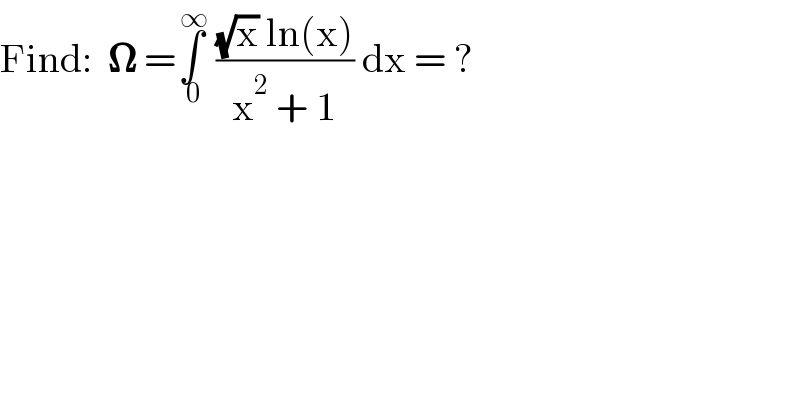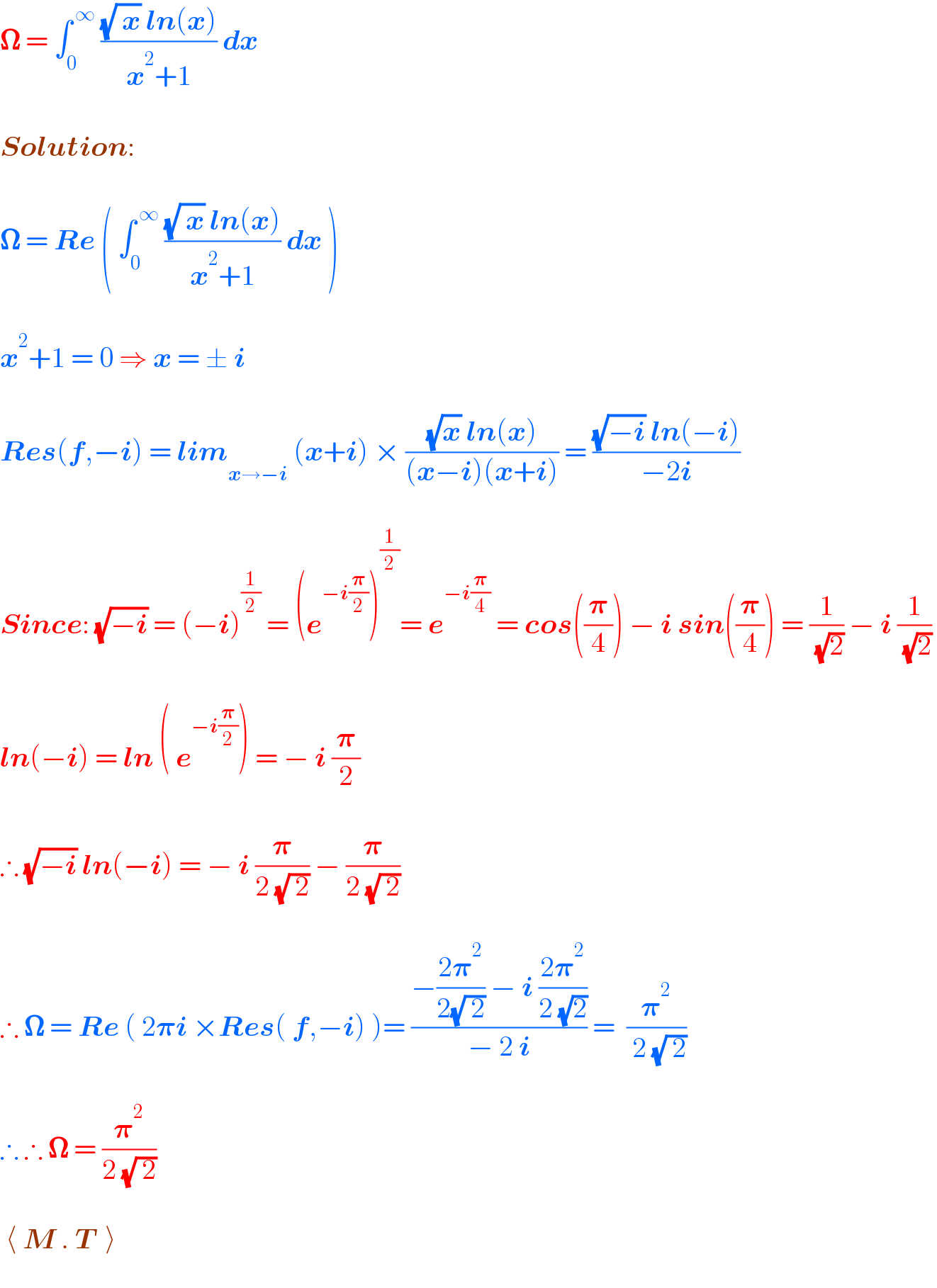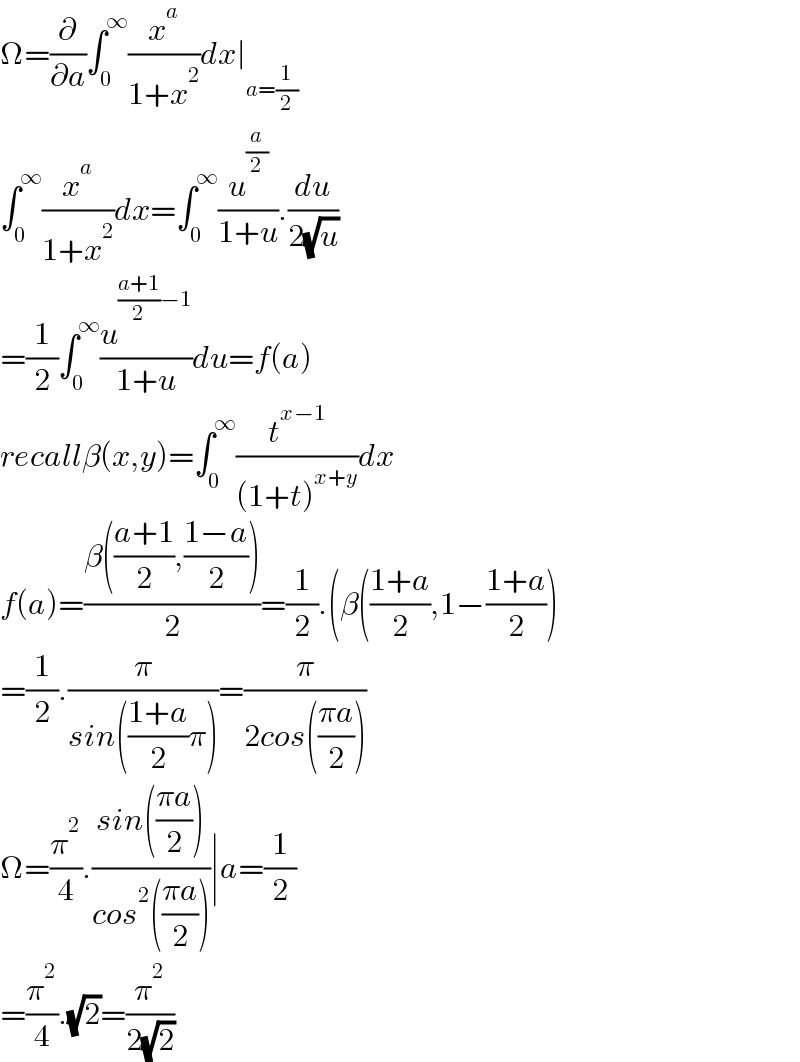Question Number 155479 by mathdanisur last updated on 01/Oct/21

$$\mathrm{Find}:\:\:\boldsymbol{\Omega}\:=\underset{\:\mathrm{0}} {\overset{\:\infty} {\int}}\:\frac{\sqrt{\mathrm{x}}\:\mathrm{ln}\left(\mathrm{x}\right)}{\mathrm{x}^{\mathrm{2}} \:+\:\mathrm{1}}\:\mathrm{dx}\:=\:? \\ $$
Commented by mathdanisur last updated on 01/Oct/21

$$\mathrm{Very}\:\mathrm{nice}\:\mathrm{solution},\:\mathrm{thank}\:\mathrm{you}\:\boldsymbol{\mathrm{S}}\mathrm{er} \\ $$
Commented by aliyn last updated on 01/Oct/21

$$\boldsymbol{\Omega}\:=\:\int_{\mathrm{0}} ^{\:\infty} \:\frac{\sqrt{\:\boldsymbol{{x}}}\:\boldsymbol{{ln}}\left(\boldsymbol{{x}}\right)}{\boldsymbol{{x}}^{\mathrm{2}} +\mathrm{1}}\:\boldsymbol{{dx}} \\ $$$$ \\ $$$$\boldsymbol{{Solution}}: \\ $$$$ \\ $$$$\boldsymbol{\Omega}\:=\:\boldsymbol{{Re}}\:\left(\:\int_{\mathrm{0}} ^{\:\infty} \:\frac{\sqrt{\:\boldsymbol{{x}}}\:\boldsymbol{{ln}}\left(\boldsymbol{{x}}\right)}{\boldsymbol{{x}}^{\mathrm{2}} +\mathrm{1}}\:\boldsymbol{{dx}}\:\right) \\ $$$$ \\ $$$$\boldsymbol{{x}}^{\mathrm{2}} +\mathrm{1}\:=\:\mathrm{0}\:\Rightarrow\:\boldsymbol{{x}}\:=\:\pm\:\boldsymbol{{i}}\: \\ $$$$ \\ $$$$\boldsymbol{{Res}}\left(\boldsymbol{{f}},−\boldsymbol{{i}}\right)\:=\:\boldsymbol{{lim}}_{\boldsymbol{{x}}\rightarrow−\boldsymbol{{i}}} \:\left(\boldsymbol{{x}}+\boldsymbol{{i}}\right)\:×\:\frac{\sqrt{\boldsymbol{{x}}}\:\boldsymbol{{ln}}\left(\boldsymbol{{x}}\right)}{\left(\boldsymbol{{x}}−\boldsymbol{{i}}\right)\left(\boldsymbol{{x}}+\boldsymbol{{i}}\right)}\:=\:\frac{\sqrt{−\boldsymbol{{i}}}\:\boldsymbol{{ln}}\left(−\boldsymbol{{i}}\right)}{−\mathrm{2}\boldsymbol{{i}}} \\ $$$$ \\ $$$$\boldsymbol{{Since}}:\:\sqrt{−\boldsymbol{{i}}}\:=\:\left(−\boldsymbol{{i}}\right)^{\frac{\mathrm{1}}{\mathrm{2}}} \:=\:\left(\boldsymbol{{e}}^{−\boldsymbol{{i}}\frac{\boldsymbol{\pi}}{\mathrm{2}}} \right)^{\frac{\mathrm{1}}{\mathrm{2}}} =\:\boldsymbol{{e}}^{−\boldsymbol{{i}}\frac{\boldsymbol{\pi}}{\mathrm{4}}} \:=\:\boldsymbol{{cos}}\left(\frac{\boldsymbol{\pi}}{\mathrm{4}}\right)\:−\:\boldsymbol{{i}}\:\boldsymbol{{sin}}\left(\frac{\boldsymbol{\pi}}{\mathrm{4}}\right)\:=\:\frac{\mathrm{1}}{\:\sqrt{\mathrm{2}}}\:−\:\boldsymbol{{i}}\:\frac{\mathrm{1}}{\:\sqrt{\mathrm{2}}}\: \\ $$$$ \\ $$$$\boldsymbol{{ln}}\left(−\boldsymbol{{i}}\right)\:=\:\boldsymbol{{ln}}\:\left(\:\boldsymbol{{e}}^{−\boldsymbol{{i}}\frac{\boldsymbol{\pi}}{\mathrm{2}}} \right)\:=\:−\:\boldsymbol{{i}}\:\frac{\boldsymbol{\pi}}{\mathrm{2}} \\ $$$$ \\ $$$$\therefore\:\sqrt{−\boldsymbol{{i}}}\:\boldsymbol{{ln}}\left(−\boldsymbol{{i}}\right)\:=\:−\:\boldsymbol{{i}}\:\frac{\boldsymbol{\pi}}{\mathrm{2}\:\sqrt{\:\mathrm{2}}}\:−\:\frac{\boldsymbol{\pi}}{\mathrm{2}\:\sqrt{\:\mathrm{2}}}\: \\ $$$$ \\ $$$$\therefore\:\boldsymbol{\Omega}\:=\:\boldsymbol{{Re}}\:\left(\:\mathrm{2}\boldsymbol{\pi{i}}\:×\boldsymbol{{Res}}\left(\:\boldsymbol{{f}},−\boldsymbol{{i}}\right)\:\right)=\:\frac{−\frac{\mathrm{2}\boldsymbol{\pi}^{\mathrm{2}} }{\mathrm{2}\sqrt{\:\mathrm{2}}}\:−\:\boldsymbol{{i}}\:\frac{\mathrm{2}\boldsymbol{\pi}^{\mathrm{2}} }{\mathrm{2}\:\sqrt{\mathrm{2}}}}{−\:\mathrm{2}\:\boldsymbol{{i}}}\:=\:\:\frac{\boldsymbol{\pi}^{\mathrm{2}} }{\:\mathrm{2}\:\sqrt{\:\mathrm{2}}}\:\: \\ $$$$ \\ $$$$\therefore\:\therefore\:\boldsymbol{\Omega}\:=\:\frac{\boldsymbol{\pi}^{\mathrm{2}} }{\mathrm{2}\:\sqrt{\:\mathrm{2}}}\: \\ $$$$ \\ $$$$\:\langle\:\boldsymbol{{M}}\:.\:\boldsymbol{{T}}\:\:\rangle \\ $$
Commented by mindispower last updated on 01/Oct/21

$${Hello}\:{sir}\:{i}\:{hop}\:{all}\:{going}\:{well} \\ $$$${Nice}\:{solution}\:{By}\:{using}\:{Residu}\:{Theorem} \\ $$$${have}\:{a}\:{nice}\:{day} \\ $$
Commented by aliyn last updated on 01/Oct/21

$$\boldsymbol{{thank}}\:\boldsymbol{{you}}\:\boldsymbol{{sir}}\:! \\ $$
Commented by tabata last updated on 01/Oct/21

$$\boldsymbol{{thank}}\:\boldsymbol{{you}}\:\boldsymbol{{sir}} \\ $$
Answered by mindispower last updated on 01/Oct/21

$$\Omega=\frac{\partial}{\partial{a}}\int_{\mathrm{0}} ^{\infty} \frac{{x}^{{a}} }{\mathrm{1}+{x}^{\mathrm{2}} }{dx}\mid_{{a}=\frac{\mathrm{1}}{\mathrm{2}}} \\ $$$$\int_{\mathrm{0}} ^{\infty} \frac{{x}^{{a}} }{\mathrm{1}+{x}^{\mathrm{2}} }{dx}=\int_{\mathrm{0}} ^{\infty} \frac{{u}^{\frac{{a}}{\mathrm{2}}} }{\mathrm{1}+{u}}.\frac{{du}}{\mathrm{2}\sqrt{{u}}} \\ $$$$=\frac{\mathrm{1}}{\mathrm{2}}\int_{\mathrm{0}} ^{\infty} \frac{{u}^{\frac{{a}+\mathrm{1}}{\mathrm{2}}−\mathrm{1}} }{\mathrm{1}+{u}}{du}={f}\left({a}\right) \\ $$$${recall}\beta\left({x},{y}\right)=\int_{\mathrm{0}} ^{\infty} \frac{{t}^{{x}−\mathrm{1}} }{\left(\mathrm{1}+{t}\right)^{{x}+{y}} }{dx} \\ $$$${f}\left({a}\right)=\frac{\beta\left(\frac{{a}+\mathrm{1}}{\mathrm{2}},\frac{\mathrm{1}−{a}}{\mathrm{2}}\right)}{\mathrm{2}}=\frac{\mathrm{1}}{\mathrm{2}}.\left(\beta\left(\frac{\mathrm{1}+{a}}{\mathrm{2}},\mathrm{1}−\frac{\mathrm{1}+{a}}{\mathrm{2}}\right)\right. \\ $$$$=\frac{\mathrm{1}}{\mathrm{2}}.\frac{\pi}{{sin}\left(\frac{\mathrm{1}+{a}}{\mathrm{2}}\pi\right)}=\frac{\pi}{\mathrm{2}{cos}\left(\frac{\pi{a}}{\mathrm{2}}\right)} \\ $$$$\Omega=\frac{\pi^{\mathrm{2}} }{\mathrm{4}}.\frac{{sin}\left(\frac{\pi{a}}{\mathrm{2}}\right)}{{cos}^{\mathrm{2}} \left(\frac{\pi{a}}{\mathrm{2}}\right)}\mid{a}=\frac{\mathrm{1}}{\mathrm{2}} \\ $$$$=\frac{\pi^{\mathrm{2}} }{\mathrm{4}}.\sqrt{\mathrm{2}}=\frac{\pi^{\mathrm{2}} }{\mathrm{2}\sqrt{\mathrm{2}}} \\ $$
Commented by mathdanisur last updated on 01/Oct/21

$$\mathrm{Very}\:\mathrm{nice}\:\mathrm{solution},\:\mathrm{thank}\:\mathrm{you}\:\boldsymbol{\mathrm{S}}\mathrm{er} \\ $$
Commented by mindispower last updated on 04/Oct/21

$${thanks}\:{Sir}\:{Withe}\:{plesur} \\ $$
